
Greeves History Highlights

Greeves motorcycles began as a manufacturer of 3-wheeled cars for the disabled. Bert Greeves designed a vehicle for his cousin who had complained of the inadequacy of the typical battery powered units commonly available. Bert did the industry one better by producing a gas powered car that offered greater range and mobility. Invacar Limited was formed in 1946, and the small firm did surprisingly well.
Greeves was a motorcycle enthusiast and believed there was a market opportunity for a line of good, lightweight motorcycles. In the early nineteen fifties, he began to design the machines and introduced his first two units to the motorcycling public in 1954. They were both dirt bikes, one being a trials machine, the other a scrambler model. These early units were powered by Villiers 200cc two strokes engines. From the start, these motorcycles were easily identified by two unique Greeves features: the leading link front fork and the cast aluminum "down beam".
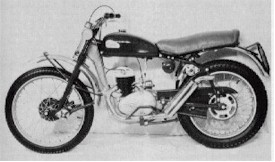
The first Greeves trials bike, 1954.
Greeves believed competition improved the breed and could provide valuable exposure of the company's name to potential buyers. In 1957 he went racing with a highly regarded motocrosser at the time, Brian Stonebridge. Stonebridge enjoyed considerable success in Britain, and the small company's sales began to grow. In 1958, the pair traveled to the European continent to compete in the newly established FIM 250cc motocross class. In traveling Europe, Bert was shaken to discover that the British were "regarded as rather a second-rate race in sporting spheres". This revelation caused Greeves to redouble the company's racing efforts. The commitment paid off quickly, with Stonebridge garnering two second place finishes in the championship standings in the ensuing two years. Following the tragic death of Stonebridge in an auto accident, the company hired Dave Bickers as their rider. With a new motorcycle punched out to 246cc, Bickers won the European championship in both 1960 and 1961.
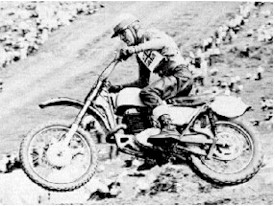
Dave Bickers racing at Glastonbury, England.
Photo: Brian Holder
It was about this time that Greeves motorcycles began to show up in western states desert races. The little silver and blue Hawkstones began to change peoples ideas about what kind of hardware was needed to win. Before the Greeves, lightweight bikes were a joke. They were unreliable and had difficulty even finishing. Greeves changed all that. They not only finished, but were often beating the large bore desert sleds of the day. For a ten year stretch, from 1959 to 1969, Greeves motorcycles became the ones to beat.

1960 Hawkstone Scrambler
Greeves built road bikes as well as off road motorcycles. By 1962, there was 11 models, four of which were roadsters.

The 1962 Mark II roadster with Villiers 250cc twin.
In 1962, Greeves introduced a new Villiers powerplant featuring a Greeves designed cylinder head and barrel. The new cylinder featured revised porting for better power and the familiar Greeves "square barrel" look. A year later, the company produced the Silverstone road racer, an economical, 250cc bike for the privateer.

The 1963 Silverstone road racer.
The reliability of the Villiers motor began to suffer as more and more horsepower was coaxed out of the square barrel design. It became clear to Greeves that an entirely new engine was needed to remain competitive in both speed and reliability. That new design made its debut in the 1964 250cc Greeves Challenger. The motor featured the Greeves head and barrel, a lower end built by the Alpha Company and an Albion gearbox. By 1967, a 360cc version was available. These were highly successful motorcycles, enjoying popularity in both desert racing and motocross events.
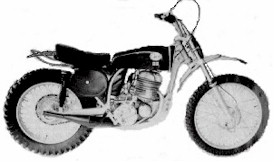
360 cc Challenger, 1967
Greeves also experienced considerable success in trials competition. In 1964, Don Smith won the European Trials Championship aboard a Scottish Trials. In 1967 he won a second time, riding an Anglian.
The Scottish Trials models were produced from 1960 through 1965, with introduction of the Anglian in 1966.
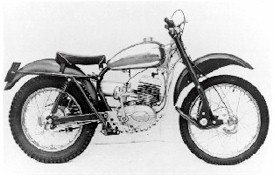
Greeves Scottish Trials, '62-'64.
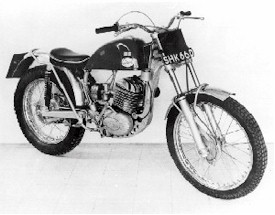
1967 THS Anglian Trials.
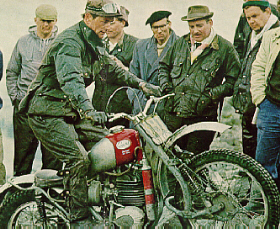
Don Smith, 1967, on an Anglian
Photo: Brian Holder
The last of the Challenger models was produced in 1968, replaced by the 250 and 380cc Griffon motocrossers in 1969. By this time the familiar leading link fork was no longer offered, having been replaced by conventional telescopic forks. The leading link design could not be stretched to allow the now 7" travel of the telescopics. At various times the bikes were fitted with Ceriani, Metal Profile or Telesco's. Gone too was the familiar aluminum front down beam, more a victim of marketing strategy than engineering necessity. A new frame of Reynolds 531 chrome moly with a conventional down tube was now standard.
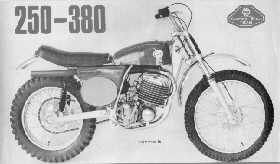
Griffon marketing brochure, 1969.
Shortly after introduction of the Griffon line, a collaborative engineering effort began between the Greeves company and Dr. Gordon Blair of Queen's University, Belfast. This collaboration resulted in the last significant bike to be sold by Greeves, the Griffon QUB (Queen's University Belfast).
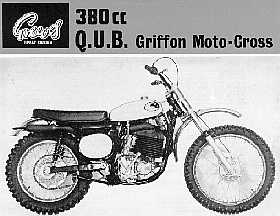
1973 Greeves 380cc QUB Greeves marketing brochure, 1973.
Driven by the market and competitive demand for greater horsepower, Greeves turned to Dr. Blair to help squeeze more ponies out of the Griffon 380. A highly regarded expert in two stroke theory, Dr. Blair and his staff re-engineered the ports and exhaust system, bumping horsepower from 38 to 44. The new bike was called the QUB and although production began in 1971, units did not arrive in the U.S. until 1972. A second QUB model, called the MKII was introduced in 1976, one year before the company closed its doors.
As an aside, you should know that Dr. Blair is still very active in two stroke R&D. His most recent publication, Design and Simulation of Two Stroke Engines, came out in 1996. It is considered a bible in the field of two stroke theory and is available from the Society of Automotive Engineers (http://www.sae.org) .
The QUB was a superb machine, but it alone was unable to stem the tide of competition from Japan. Joel Robert captured three straight FIM 250cc world championships (1970-'72) and Roger Decoster nailed down three 500cc world championships (1971-'73) aboard Suzukis. This ended the domination of world competition by the smaller European marks and sales of these brands declined rapidly. By the end of the 1970's, Greeves, DOT, Cotton, AJS, BSA and Triumph had all been driven out of business.
Copyright all rights reserved. Frank Conley's Greeves
